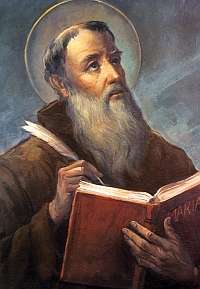Lawrence of Brindisi
Lawrence of Brindisi (22 July 1559 – 22 July 1619), born Giulio Cesare Russo, was a Roman Catholic priest and a theologian as well as a member of the Order of Friars Minor Capuchin. An accomplished linguist, in addition to his native Italian, Lawrence could read and speak Latin, Hebrew, Greek, German, Bohemian, Spanish, and French fluently. Lawrence was ordained a priest at the age of 23. Lawrence was beatified on 1 June 1783 and canonized as a saint on 8 December 1881.
 | |
| Priest; Doctor of the Church | |
| Born | 22 July 1559 Brindisi, Kingdom of Naples |
| Died | 22 July 1619 (aged 60) Lisbon, Portugal |
| Venerated in | Roman Catholic Church |
| Beatified | 1 June 1783, Saint Peter's Basilica, Papal States by Pope Pius VI |
| Canonized | 8 December 1881, Saint Peter's Basilica, Kingdom of Italy by Pope Leo XIII |
| Major shrine | Villafranca del Bierzo |
| Feast | 21 July |
| Attributes |
|
| Patronage | Brindisi |
Biography
Giulio Cesare Russo was born in Brindisi, Kingdom of Naples, to a family of Venetian merchants. After the early death of his parents, he was raised by his uncle and educated at Saint Mark's College in Venice. Cesare joined the Capuchins in Verona as Brother Lawrence. He received further instruction from the University of Padua. An accomplished linguist, in addition to his native Italian, Lawrence could read and speak Latin, Hebrew, Greek, German, Bohemian, Spanish, and French fluently. Lawrence was ordained a priest at the age of 23.[1]
At the age of thirty-one, Lawrence was elected superior of the Capuchin Franciscan province of Tuscany.[1] He was appointed definitor general to Rome for the Capuchins in 1596; Pope Clement VIII assigned him the task of preaching to the Jews in the city. He was sufficiently proficient in Hebrew that the rabbis assumed he had been a convert from Judaism. Beginning in 1599, Lawrence established Capuchin monasteries in modern Germany and Austria, furthering the Counter-Reformation and bringing many Protestants back to the Catholic faith.[2]
In 1601, he served as the imperial chaplain for the army of Rudolph II, Holy Roman Emperor, and successfully recruited Philippe Emmanuel, Duke of Mercœur, to help fight against the Ottoman Turks. He then led the army during the brief liberation of Székesfehérvár in Hungary from the Ottoman Empire, armed only with a crucifix.
In 1602, he was elected vicar general of the Capuchin friars, at that time the highest office in the Order.[1] He was elected again in 1605, but refused the office. He entered the service of the Holy See, becoming papal nuncio to Bavaria. After serving as nuncio to Spain, he retired to a monastery in 1618. He was recalled as a special envoy to the King of Spain regarding the actions of the Viceroy of Naples in 1619, and after finishing his mission, died on his birthday in Lisbon.
He was entombed at the Poor Clares' Convento de la Anunciada (Convent of the Annunciation) in Villafranca del Bierzo, Spain.[3]
Favourite blessing
Nos cum prole pia |
Mary, with Her loving Son, |
Works
St. Lawrence of Brindisi Complete Works were published in 15 volumes, in a critical edition, between 1926 and 1956. They comprise:
- Mariale
- Lutheranismi hypotyposis
- Explanatio in Genesim
- Quadragesimale primum
- Quadragesimale secundum
- Quadragesimale tertium
- Quadragesimale quartum
- Adventus
- Dominicalia
- Sanctorale
- Sermones de tempore
His original manuscripts comprise 13 volumes in parchment and are located at the Archivio dei Cappuccini di Mestre.
See also
- Francis of Assisi
- St. Lawrence Seminary High School
- Saint Lawrence of Brindisi, patron saint archive
References
- "Saint Lawrence of Brindisi", Franciscan Media
- Andrew J.G. Drenas The Standard Bearer of the Roman Church: Lawrence of Brindisi and Capuchin Missions in the Holy Roman Empire (1599-1613) (Washington, DC: The Catholic University of America Press), 2018. ISBN 978-0-8132-3037-5
- Thielen, Daniel (2015). Saints in Rome and beyond. Lulu Press Inc. p. 138. ISBN 978-0-9861547-2-0.
-

- "Closing prayers said at the Rosary Vigils and Sunday Holy Hours". St Michael's World Apostolate. Archived from the original on 2016-06-30. Retrieved 2018-12-31.
External links
| Wikimedia Commons has media related to Lawrence of Brindisi. |